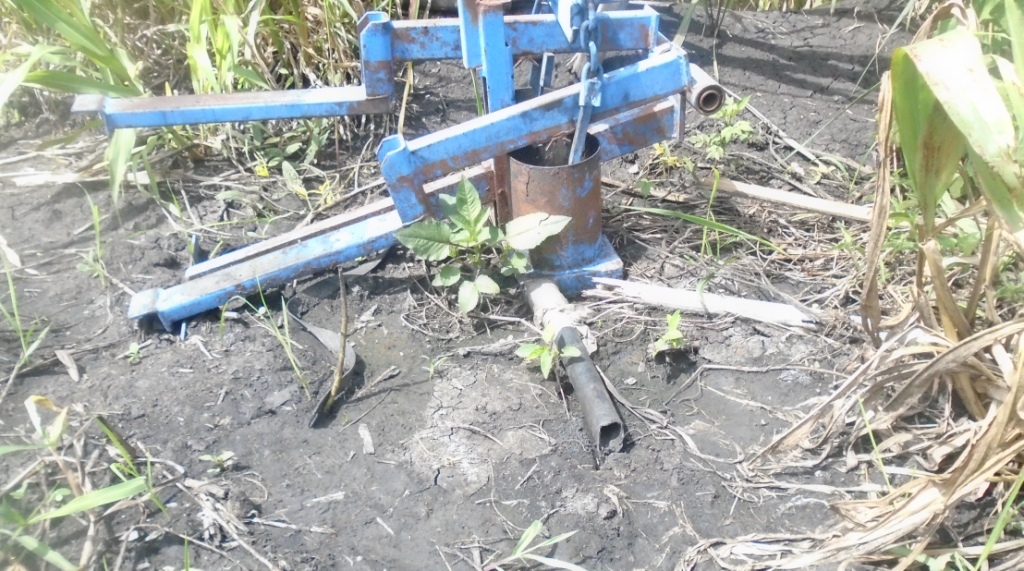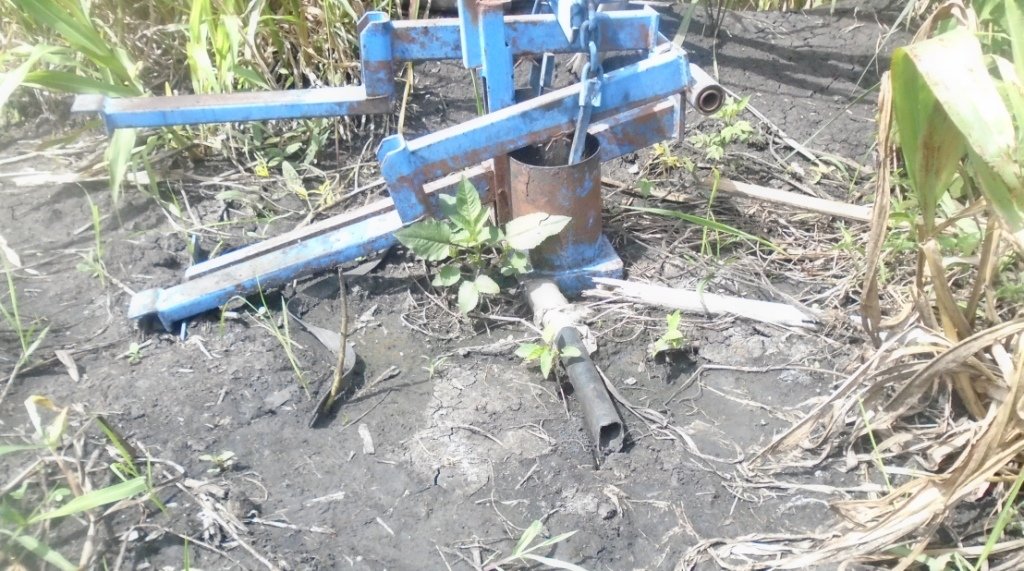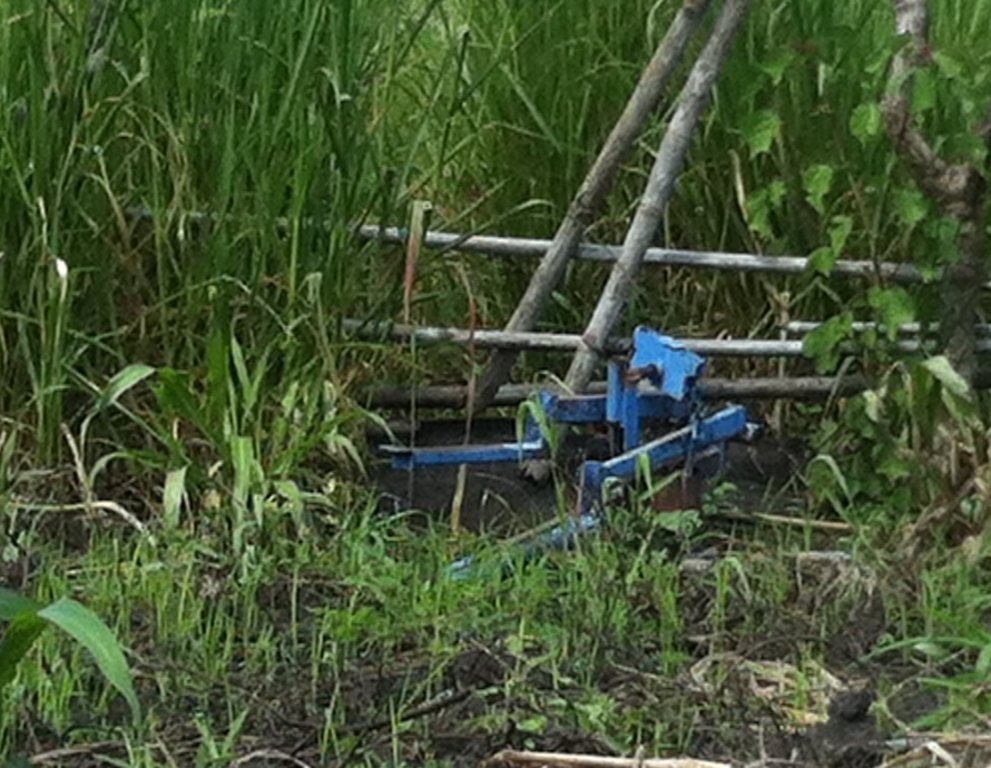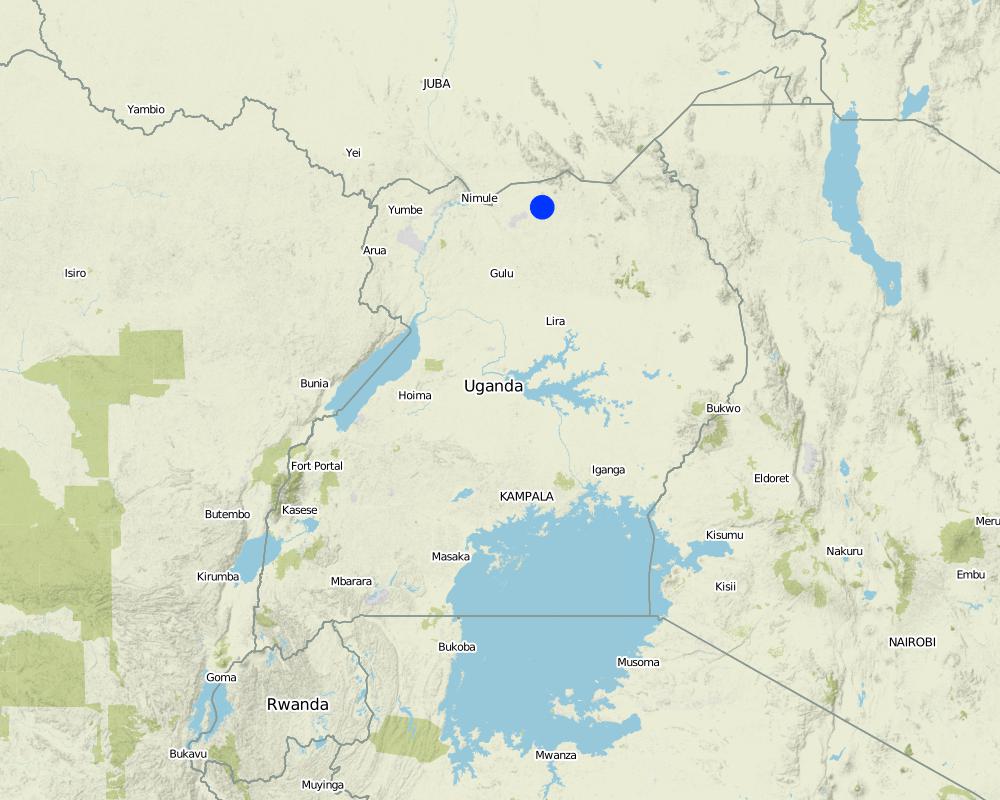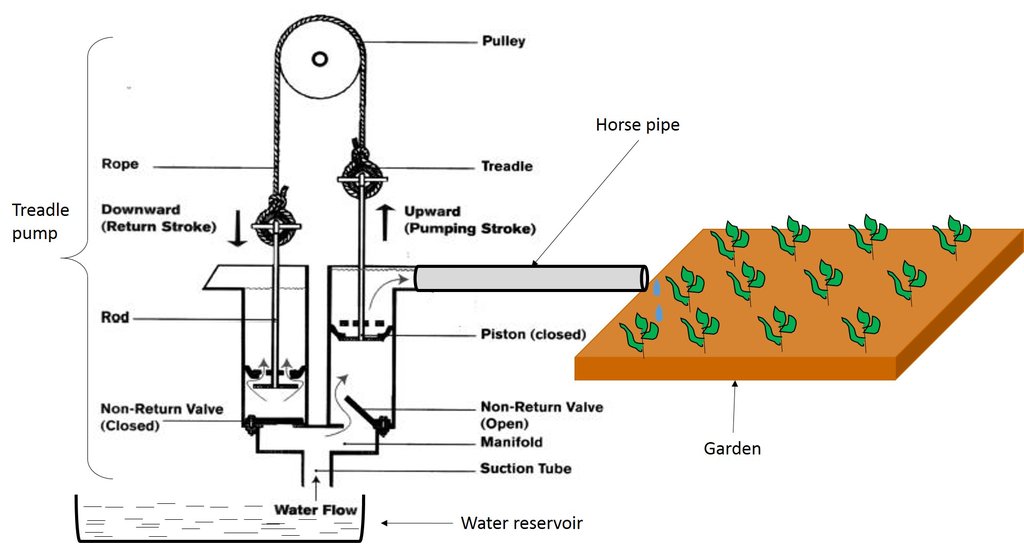Low-cost irrigation with a treadle pump [乌干达]
- 创建:
- 更新:
- 编制者: Bernard Fungo
- 编辑者: JOY TUKAHIRWA, Kamugisha Rick Nelson, betty adoch, Sunday Balla Amale
- 审查者: Donia Mühlematter, John Stephen Tenywa, Nicole Harari, Renate Fleiner, Stephanie Jaquet, Alexandra Gavilano
Money Maker
technologies_2788 - 乌干达
查看章节
全部展开 全部收起1. 一般信息
1.2 参与该技术评估和文件编制的资源人员和机构的联系方式
有助于对技术进行记录/评估的项目名称(如相关)
Scaling-up SLM practices by smallholder farmers (IFAD)有助于对技术进行记录/评估的机构名称(如相关)
CDE Centre for Development and Environment (CDE Centre for Development and Environment) - 瑞士1.3 关于使用通过WOCAT记录的数据的条件
编制者和关键资源人员接受有关使用通过WOCAT记录数据的条件。:
是
1.4 所述技术的可持续性声明
这里所描述的技术在土地退化方面是否存在问题,导致无法被认为是一种可持续的土地管理技术?:
否
注释:
Irrigation of annual and perennial cropland is a buffer against crop failure caused by prolonged drought, ensuring adaptation to change in weather patterns.
2. SLM技术的说明
2.1 技术简介
技术定义:
Use of the manual Treadle pump is a relatively cheap and effective way to ensure adequate soil moisture to ensure crop production throughout the year.
2.2 技术的详细说明
说明:
Northern Uganda receives low rainfall (600 – 1100 mm annually) and experiences longer dry spells (4 – 5 months) compared to other areas of the country. This makes the region vulnerable to drought, thereby increasing the risk of crop failure in most cases. Therefore, irrigation has the potential to improve land productivity. However, moving water from its source into cropland is labor-demanding for farmers, thereby making irrigation farming less profitable compared to rain-fed agriculture, even with the erratic nature of rainfall.
To engage in profitable irrigation farming, farmers have resorted to use simple contraptions such as the treadle pump. The treadle pump is used to move water from its source (which maybe a well, underground tank, valley dam or reserve tank) into the cropland with significantly lower labour requirements. This reduces the cost of irrigation and improves profitability. Treadle pumps are powered by human effort, with the legs and feet peddling up and down on treadles/ peddles that are connected to two small piston pumps. The pump is connected to a hosepipe, which dispenses the water, running from the water source into the cropland. This machine is gender-responsive because its energy requirements are very low and can thus be operated by any gender (men, women and teenagers).
Mechanically, a treadle pump is a suction pump that is placed on top of a well. It is designed to lift water from a depth of seven meters or less. It can lift five to seven cubic meters of water per hour (5-7 m3 hr-1) from wells and boreholes and can also be used to draw water from lakes and rivers. The pumping is activated by stepping up and down on a treadle/ peddles, which drive the pistons, creating cylinder suction that draws groundwater to the surface. The treadle pump can do most of the work done by a motorized pump, but costs considerably less. Its cost, including installation ranges between US$100 and 300. Since it is not motorized, it can also cost less (e.g. by 50%) to operate than a motorized pump. Many treadle pumps are manufactured locally, but they can be challenging to produce up to the right standards without highly skilled welders and production hardware. Use of manual rather than fossil fuel means that the technology is carbon neutral, another important climate smart dimension of the pump.
Despite its benefits, the adoption rate has been low due to the initial cost, which although is relatively lower compared to the motorized pumps, is still unaffordable by most smallholder farmers. To overcome this high cost, some farmers form groups, purchase one piece and share the cost among the group members. The second problem with this technology is the lack of nearby water sources, which may be a serious challenge or where the water table is very low and/or where porous soils do not allow significant harvestable water during rainy seasons. To ensure the technology is sustainable, farmers are building concrete tanks to harvest water from the roofs of their houses when it rains and use it for irrigation when the drought sets-in.
2.3 技术照片
2.4 技术视频
日期:
12/5/2017
位置:
Lamwo
2.5 已应用该技术的、本评估所涵盖的国家/地区/地点
国家:
乌干达
区域/州/省:
Northern
有关地点的进一步说明:
Padibe s/county Lamwo District
具体说明该技术的分布:
- 均匀地分布在一个区域
如果不知道精确的区域,请注明大致覆盖的区域:
- < 0.1 平方千米(10 公顷)
Map
×2.6 实施日期
注明实施年份:
2012
如果不知道确切的年份,请说明大概的日期:
- 不到10年前(最近)
2.7 技术介绍
详细说明该技术是如何引入的:
- 通过项目/外部干预
注释(项目类型等):
The project was called Action Against Hunger.
3. SLM技术的分类
3.1 该技术的主要目的
- 改良生产
- 降低灾害风险
- 适应气候变化/极端天气及其影响
- 创造有益的经济影响
3.2 应用该技术的当前土地利用类型

农田
- 一年一作
年作 - 具体指明作物:
- 谷物类 - 玉米
- 豆科牧草和豆类 - 豆子
- vegetables
每年的生长季节数:
- 3
具体说明:
The growing take place out the year.

牧场

森林/林地
3.4 供水
该技术所应用土地的供水:
- 混合雨水灌溉
注释:
Irrigation is only done during the dry spells or when the rains don't come as expected.
3.5 该技术所属的SLM组
- 灌溉管理(包括供水、排水)
3.6 包含该技术的可持续土地管理措施

结构措施
- S7:集水/供水/灌溉设备
3.7 该技术强调的主要土地退化类型

生物性退化
- Bl:土壤寿命损失

水质恶化
- Ha:干旱化
- Hs:地表水良变化
3.8 防止、减少或恢复土地退化
具体数量名该技术与土地退化有关的目标:
- 减少土地退化
- 适应土地退化
4. 技术规范、实施活动、投入和成本
4.1 该技术的技术图纸
技术规范(与技术图纸相关):
1. Water head should be within 7 meters from the ground.
2. The garden where watering will be done should be within 25 meters from the treadle pump if the area is flat.
3. The pump should fixed firmly in the ground to avoid falling while the peddling is going-on.
作者:
Bernard Fungo
日期:
12/5/2017
4.2 有关投入和成本计算的一般信息
具体说明成本和投入是如何计算的:
- 每个技术单元
指定单位:
Piece
指定单位面积(如相关):
One piece of treadle pump with its tubing to where the garden is
其它/国家货币(具体说明):
Uganda Shilings
如相关,注明美元与当地货币的汇率(例如1美元=79.9巴西雷亚尔):1美元=:
3500.0
注明雇用劳工的每日平均工资成本:
5000
4.3 技术建立活动
| 活动 | 时间(季度) | |
|---|---|---|
| 1. | Buying treadle pump | Once |
| 2. | Connection | Once |
| 3. | Pumping | Once a day |
4.4 技术建立所需要的费用和投入
| 对投入进行具体说明 | 单位 | 数量 | 单位成本 | 每项投入的总成本 | 土地使用者承担的成本% | |
|---|---|---|---|---|---|---|
| 劳动力 | Pumping | Man/days | 30.0 | 5000.0 | 150000.0 | 100.0 |
| 设备 | Treadle Pump | Piece | 1.0 | 1000000.0 | 1000000.0 | 100.0 |
| 设备 | Horse pipes | Meters | 50.0 | 3000.0 | 150000.0 | 100.0 |
| 技术建立所需总成本 | 1300000.0 | |||||
| 技术建立总成本,美元 | 371.43 | |||||
4.5 维护/经常性活动
| 活动 | 时间/频率 | |
|---|---|---|
| 1. | pumping | when needed |
| 2. | Replacement of pipe | When needed |
4.6 维护/经常性活动所需要的费用和投入(每年)
| 对投入进行具体说明 | 单位 | 数量 | 单位成本 | 每项投入的总成本 | 土地使用者承担的成本% | |
|---|---|---|---|---|---|---|
| 劳动力 | Labour for pumping water | Mandays | 30.0 | 5000.0 | 150000.0 | 100.0 |
| 设备 | Treddle pump | Piece | 1.0 | 1050000.0 | 1050000.0 | |
| 设备 | pipe | Meters | 30.0 | 70000.0 | 2100000.0 | |
| 技术维护所需总成本 | 3300000.0 | |||||
| 技术维护总成本,美元 | 942.86 | |||||
4.7 影响成本的最重要因素
描述影响成本的最决定性因素:
Cost for acquiring the pump and the cost of labor for running the pump.
5. 自然和人文环境
5.1 气候
年降雨量
- < 250毫米
- 251-500毫米
- 501-750毫米
- 751-1,000毫米
- 1,001-1,500毫米
- 1,501-2,000毫米
- 2,001-3,000毫米
- 3,001-4,000毫米
- > 4,000毫米
注明所考虑的参考气象站名称:
Gulu, Uganda
农业气候带
- 半湿润
5.2 地形
平均坡度:
- 水平(0-2%)
- 缓降(3-5%)
- 平缓(6-10%)
- 滚坡(11-15%)
- 崎岖(16-30%)
- 陡峭(31-60%)
- 非常陡峭(>60%)
地形:
- 高原/平原
- 山脊
- 山坡
- 山地斜坡
- 麓坡
- 谷底
垂直分布带:
- 0-100 m a.s.l.
- 101-500 m a.s.l.
- 501-1,000 m a.s.l.
- 1,001-1,500 m a.s.l.
- 1,501-2,000 m a.s.l.
- 2,001-2,500 m a.s.l.
- 2,501-3,000 m a.s.l.
- 3,001-4,000 m a.s.l.
- > 4,000 m a.s.l.
说明该技术是否专门应用于:
- 不相关
5.3 土壤
平均土层深度:
- 非常浅(0-20厘米)
- 浅(21-50厘米)
- 中等深度(51-80厘米)
- 深(81-120厘米)
- 非常深(> 120厘米)
土壤质地(表土):
- 中粒(壤土、粉土)
土壤质地(地表以下> 20厘米):
- 中粒(壤土、粉土)
表土有机质:
- 中(1-3%)
5.4 水资源可用性和质量
地下水位表:
> 50米
地表水的可用性:
中等
水质(未处理):
仅供农业使用(灌溉)
水的盐度有问题吗?:
否
该区域正在发生洪水吗?:
否
5.5 生物多样性
物种多样性:
- 中等
栖息地多样性:
- 中等
5.6 应用该技术的土地使用者的特征
定栖或游牧:
- 定栖的
生产系统的市场定位:
- 混合(生计/商业)
非农收入:
- 收入的10-50%
相对财富水平:
- 平均水平
个人或集体:
- 个人/家庭
机械化水平:
- 手工作业
- 畜力牵引
性别:
- 男人
土地使用者的年龄:
- 中年人
5.7 应用该技术的土地使用者使用的平均土地面积
- < 0.5 公顷
- 0.5-1 公顷
- 1-2 公顷
- 2-5公顷
- 5-15公顷
- 15-50公顷
- 50-100公顷
- 100-500公顷
- 500-1,000公顷
- 1,000-10,000公顷
- > 10,000公顷
这被认为是小规模、中规模还是大规模的(参照当地实际情况)?:
- 中等规模的
5.8 土地所有权、土地使用权和水使用权
土地所有权:
- 个人,未命名
土地使用权:
- 个人
用水权:
- 个人
5.9 进入服务和基础设施的通道
健康:
- 贫瘠
- 适度的
- 好
教育:
- 贫瘠
- 适度的
- 好
技术援助:
- 贫瘠
- 适度的
- 好
就业(例如非农):
- 贫瘠
- 适度的
- 好
市场:
- 贫瘠
- 适度的
- 好
能源:
- 贫瘠
- 适度的
- 好
道路和交通:
- 贫瘠
- 适度的
- 好
饮用水和卫生设施:
- 贫瘠
- 适度的
- 好
金融服务:
- 贫瘠
- 适度的
- 好
6. 影响和结论性说明
6.1 该技术的现场影响
社会经济效应
生产
作物生产
作物质量
生产故障风险
土地管理
水资源可用性和质量
灌溉用水的可用性
注释/具体说明:
Increased construction of underground reservoirs and roof water harvesting have increased availability of water for irrigation.
社会文化影响
食品安全/自给自足
SLM/土地退化知识
注释/具体说明:
As the project was promoting the pump, sensitization about land degradation and options for improving management were also intruded to farmers, hence improving their knowledge on land degradation.
生态影响
减少气候和灾害风险
干旱影响
6.2 该技术的场外影响已经显现
地下水/河流污染
6.3 技术对渐变气候以及与气候相关的极端情况/灾害的暴露和敏感性(土地使用者认为的极端情况/灾害)
渐变气候
渐变气候
| 季节 | 增加或减少 | 该技术是如何应对的? | |
|---|---|---|---|
| 年温度 | 增加 | 适度 | |
| 季节性温度 | 湿季/雨季 | 增加 | 适度 |
| 年降雨量 | 减少 | 适度 | |
| 季雨量 | 旱季 | 减少 | 适度 |
气候有关的极端情况(灾害)
气候灾害
| 该技术是如何应对的? | |
|---|---|
| 干旱 | 好 |
6.4 成本效益分析
技术收益与技术建立成本相比如何(从土地使用者的角度看)?
短期回报:
消极
长期回报:
非常积极
技术收益与技术维护成本/经常性成本相比如何(从土地使用者的角度看)?
短期回报:
积极
长期回报:
非常积极
6.5 技术采用
- 1-10%
在所有采用这项技术的人当中,有多少人是自发的,即未获得任何物质奖励/付款?:
- 0-10%
6.6 适应
最近是否对该技术进行了修改以适应不断变化的条件?:
否
6.7 该技术的优点/长处/机会
| 土地使用者眼中的长处/优势/机会 |
|---|
| Increase productivity. |
| 编制者或其他关键资源人员认为的长处/优势/机会 |
|---|
| No risk of pump being stolen since it is portable, and can be shared by several farmers thus amenable to cost sharing. |
| It can be used by many genders (Youth, male and female). |
6.8 技术的弱点/缺点/风险及其克服方法
| 土地使用者认为的弱点/缺点/风险 | 如何克服它们? |
|---|---|
| Cost for acquiring. | Farmers can share the cost of purchase and they utilize in tern. |
| 编制者或其他关键资源人员认为的弱点/缺点/风险 | 如何克服它们? |
|---|---|
| The low water table in the area makes it difficult to have sufficient water when it is needed. | Construction of under ground tanks to harvest water during rainy seasons |
| Only suitable for small gardens (one acre). | Grow high value crops that take small spaces such as vegetable and fruits. |
7. 参考和链接
7.1 信息的方法/来源
- 实地考察、实地调查
2
- 与土地使用者的访谈
2
(现场)数据是什么时候汇编的?:
12/05/2017
7.2 参考可用出版物
标题、作者、年份、ISBN:
N/a
7.3 链接到网络上的相关信息
标题/说明:
N/a
链接和模块
全部展开 全部收起链接
无链接
模块
无模块


